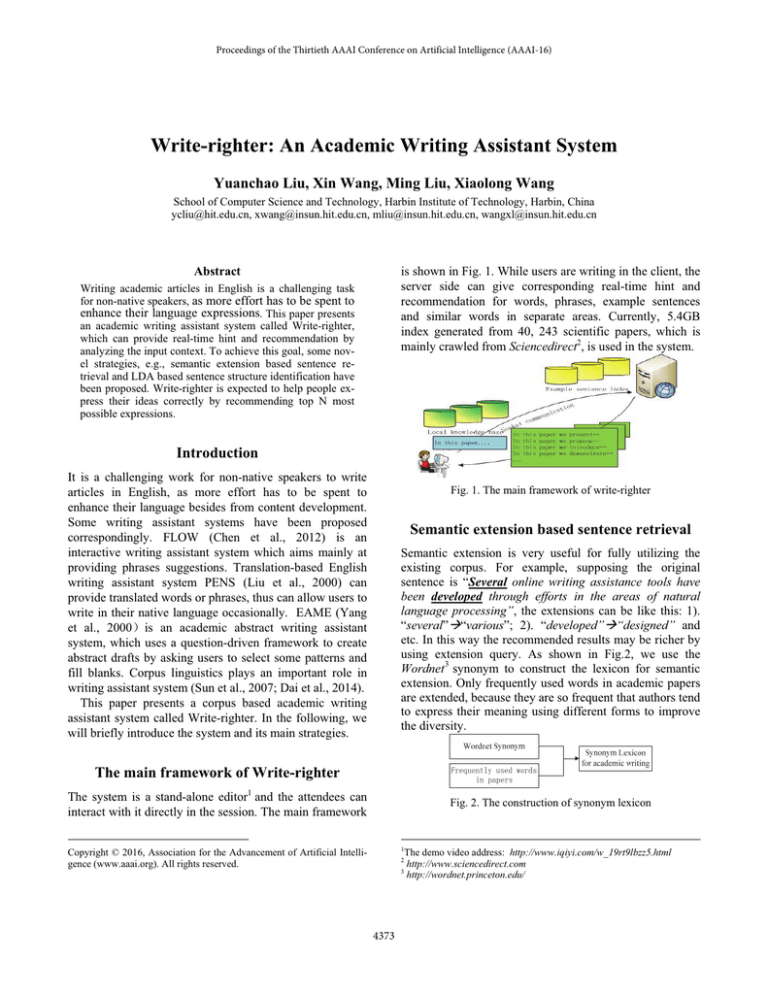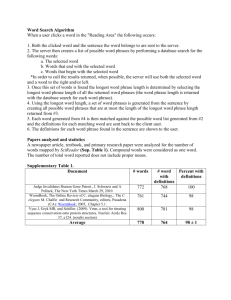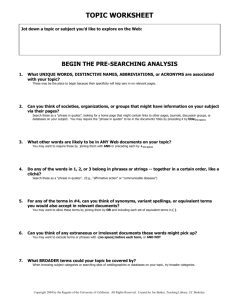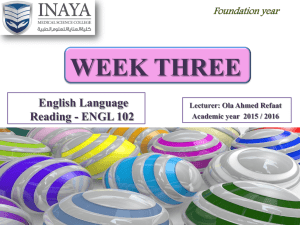
Proceedings of the Thirtieth AAAI Conference on Artificial Intelligence (AAAI-16)
Write-righter: An Academic Writing Assistant System
Yuanchao Liu, Xin Wang, Ming Liu, Xiaolong Wang
School of Computer Science and Technology, Harbin Institute of Technology, Harbin, China
ycliu@hit.edu.cn, xwang@insun.hit.edu.cn, mliu@insun.hit.edu.cn, wangxl@insun.hit.edu.cn
is shown in Fig. 1. While users are writing in the client, the
server side can give corresponding real-time hint and
recommendation for words, phrases, example sentences
and similar words in separate areas. Currently, 5.4GB
index generated from 40, 243 scientific papers, which is
mainly crawled from Sciencedirect2, is used in the system.
Abstract
Writing academic articles in English is a challenging task
for non-native speakers, as more effort has to be spent to
enhance their language expressions. This paper presents
an academic writing assistant system called Write-righter,
which can provide real-time hint and recommendation by
analyzing the input context. To achieve this goal, some novel strategies, e.g., semantic extension based sentence retrieval and LDA based sentence structure identification have
been proposed. Write-righter is expected to help people express their ideas correctly by recommending top N most
possible expressions.
Introduction
It is a challenging work for non-native speakers to write
articles in English, as more effort has to be spent to
enhance their language besides from content development.
Some writing assistant systems have been proposed
correspondingly. FLOW (Chen et al., 2012) is an
interactive writing assistant system which aims mainly at
providing phrases suggestions. Translation-based English
writing assistant system PENS (Liu et al., 2000) can
provide translated words or phrases, thus can allow users to
write in their native language occasionally. EAME (Yang
et al., 2000˅is an academic abstract writing assistant
system, which uses a question-driven framework to create
abstract drafts by asking users to select some patterns and
fill blanks. Corpus linguistics plays an important role in
writing assistant system (Sun et al., 2007; Dai et al., 2014).
This paper presents a corpus based academic writing
assistant system called Write-righter. In the following, we
will briefly introduce the system and its main strategies.
Fig. 1. The main framework of write-righter
Semantic extension based sentence retrieval
Semantic extension is very useful for fully utilizing the
existing corpus. For example, supposing the original
sentence is “Several online writing assistance tools have
been developed through efforts in the areas of natural
language processing”, the extensions can be like this: 1).
“several”Æ“various”; 2). “developed”Æ“designed” and
etc. In this way the recommended results may be richer by
using extension query. As shown in Fig.2, we use the
Wordnet 3 synonym to construct the lexicon for semantic
extension. Only frequently used words in academic papers
are extended, because they are so frequent that authors tend
to express their meaning using different forms to improve
the diversity.
The main framework of Write-righter
The system is a stand-alone editor1 and the attendees can
interact with it directly in the session. The main framework
Fig. 2. The construction of synonym lexicon
1
The demo video address: http://www.iqiyi.com/w_19rt9lbzz5.html
http://www.sciencedirect.com
3
http://wordnet.princeton.edu/
Copyright © 2016, Association for the Advancement of Artificial Intelligence (www.aaai.org). All rights reserved.
2
4373
0 d a d 1.0, 0 d E d 1.0, D E 1.0 Sim1 Fre p / Max({Frei }), i 0,..., | { p} | LDA based pattern identification
Patterns here means the frequently used expressions and
they are usually composed of non-topic words, e.g., the
underlined part in sentence “Various online writing
assistance tools have been presented through efforts in
the areas of natural language processing”.
We use mallet LDA (McCallum, et al, 2002) to get the
topic distribution. The probability that one word w is topic
Sim2
follows: 1). Get the local context
PT (w) can be calculated in formula (1) and (2).
word
p wM / ¦ p w (i ) )
(1)
C2 ; 2). Find phrases from the phrase library which
begins with C1 ; 3). Compute the comprehensive
(2)
probability of each phrase; 4). Sort these phrases using
probability Pp (C1 , C 2 ) in descending order; 5). Output
i 0
M
w
P
max( p w (i )),
i
0,..., | T | 1
where p w (i ) means the probability of term
top N phrases. There are 34, 040 phrases in the library and
we set N=20 in this paper.
w in topic i .
| T | means topic count. Bigger PT (w) usually means that
w is more likely to be a topic word. Correspondingly the
probability that w is non-topic word (structure word)
PS (w) can be calculated as follows.
P S ( w) 1 PT ( w)
Conclusions and future work
By mining from large-scale published papers, Write-righter
can provide recommendations by trying to “guess” users’
writing intention. For future, we will incorporate more user
preferences into the suggestion and make corresponding
extensions. Besides, it may be interesting to provide
revision suggestions directly by leveraging current input
sentence and good-quality expression patterns.
(3)
If P S ( w) ! PSW ( w) , then
C1 and the whole
context
|T |1
P T ( w)
Simlarity(C 2 , p) Where Sim2 denotes the cosine similarity between the
candidate phrase p and the users’ whole input. We set
D 0.6, E 0.4 in this paper. The steps are shown as
w is more likely to be the
W
structure word. Here PS (w) is the threshold, and we set
PSW (w) to 0.65 and use 10 topics by experience.
The dynamic phrase hints
Acknowledgements
The dynamic hint of phrases is based on user’s current
input, the whole context information, academic N-gram
phrase library extracted from the Sciencedirect corpus.
Suppose the local context is C1 (usually the recently
This work is funded by National Natural Science
Foundation of China (61572151).
References
inputted two words), the whole context is C 2 (all texts in
composing area), the probability of each candidate phrase
is Pp (C1 , C 2 ) , and then top N phrases with biggest
Mei-Hua Chen, Shih-Ting Huang, Hung-Ting Hsieh, Ting-Hui
Kao, Jason S. Chang. FLOW: A First-Language-Oriented Writing
Assistant System. ACL 2012, pages 157–162
Liu, Ting, Mingh Zhou, Jianfeng Gao, Endong Xun, and
Changning Huan. PENS: A Machine-Aided English Writing
System for Chinese Users. ACL 2000. pp 529-536.
probability will be ranked and selected to appear in the
phrase hint area.
(4)
phrase1, 2,... N arg max 1, 2,3.... N ( Pp (C1 , C 2 ))
Yong-Lin Yang. EAME: A question-driven abstract generating
system. Modern foreign languages, 2003: 296-305 (In Chinese)
Generally, for each phrase in the phrase hint area, the
first consecutive words must be same as C1 . The
calculation of phrase probability depends on two kinds of
information: 1). the phrase frequency Fre p in the corpus;
Yu-Chih Sun. Learner Perceptions of a Concordance Tool for
Academic Writing. Computer Assisted Language Learning. Vol.
20, No. 4, October 2007, pp. 323 – 343
CHEN H, HE B. Automated Essay Scoring by Maximizing
Human-Machine Agreement. EMNLP 2014. pages 1741-1752.
2). the similarity with the users’ input topic.
In detail, if the number of words in input area is bigger
than threshold (e.g., 30 words), the whole context
information C 2 will be considered and incorporated.
Pp (C1 , C 2 ) can be calculated by the following formulas.
Pp (C1 , C2 ) D * Sim1 E * Sim2,
McCallum, Andrew Kachites. MALLET: A Machine Learning
for Language Toolkit. http://mallet.cs.umass.edu. 2002.
Xianjun Dai, Yuanchao Liu, Xiaolong Wang. WINGS: Writing
with Intelligent Guidance and Suggestions. ACL 2014, Baltimore,
Maryland USA, June 23-24, pages 25–30.
4374







